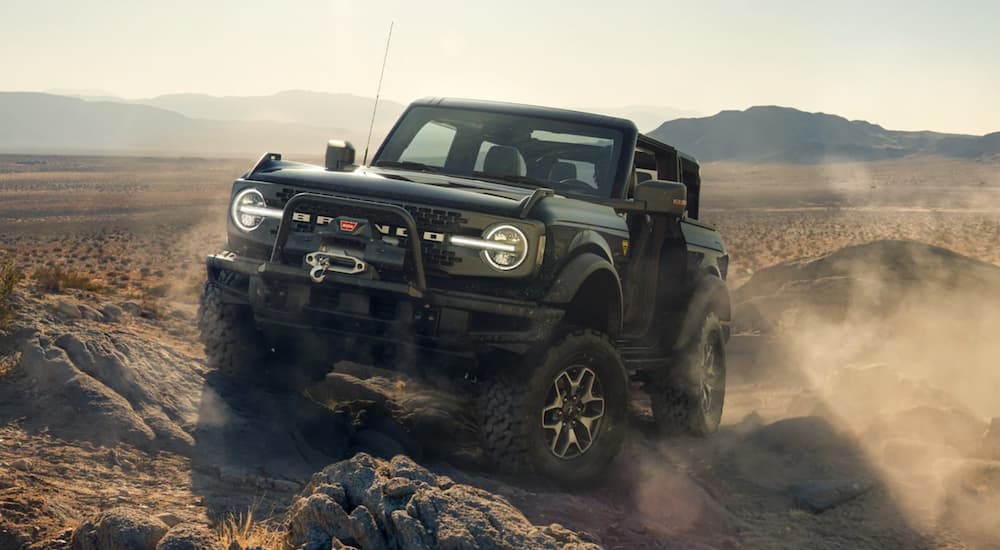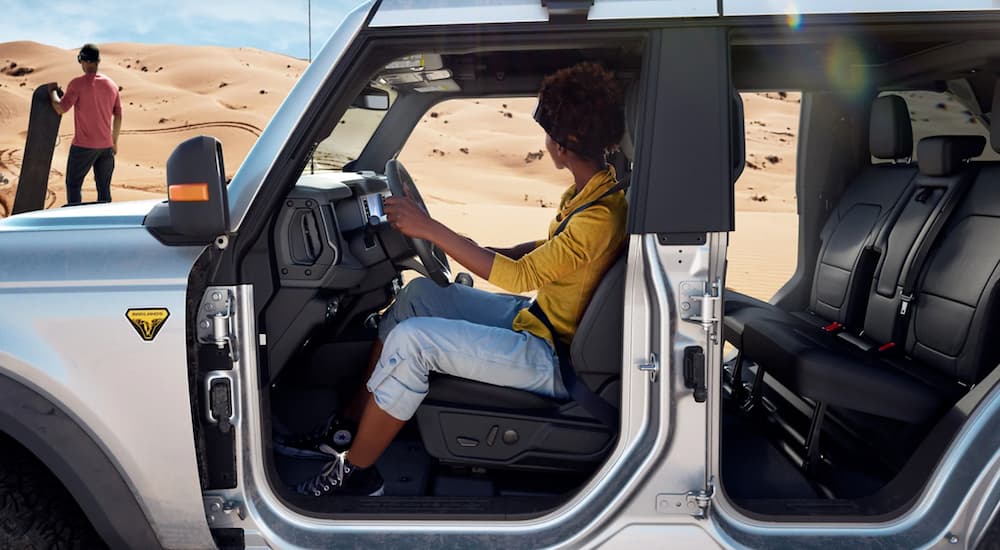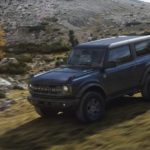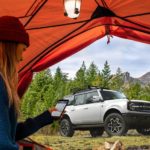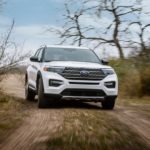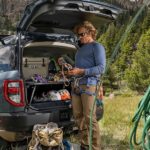An old marketing term that still holds true for the Bronco, and even the Wrangler, is “The first off-road sports car.” This is essentially the category both vehicles vie to dominate, and as such, is what both vehicles excel at. To figure out which rig makes the better off-road sports car, we must pour over every aspect of the two trucks. The engines, suspension systems, interiors, weight, even the very method of construction must be taken into account when deciding which is best when it comes to the 2021 Ford Bronco vs 2021 Jeep Wrangler. To get the full story of how these two great machines gained the status they now have, it’s necessary to go to the beginning.
Storied Rivalry
The story of the Bronco begins decades before the official introduction of the Wrangler, but decades after the heritage of the Wrangler truly began. The “first off-road sports car” was released in 1965 for the 1966 model year, capitalizing on a wave of young and adventurous car buyers who wanted style like a Mustang but preferred their performance be focused off the beaten path. And off the beaten track was where the classic Bronco shined, winning cross country off-road races and introducing a generation to the high-speed, high-jumping, and high-power thrills of Baja racing.
Meanwhile, Jeep hadn’t yet codified their purpose-built off-roader into the dual-purpose machine it would soon become. The whole point of a sports car is that it can provide many of the sensations of a race car without the compromises of a race-only car, and the same is true for the Bronco when it came to off-roading. It was a truck that could hang with the best of them when in the thick of it but still drive home in relative comfort.
The CJ series of Jeeps of the time, literally meaning Civilian Jeep, was more like the pure race cars of the factory off-roading world. They were extremely capable of trudging over rough terrain but lacked the comfort required daily use. Another advantage the Bronco had was the small-block V8s available for use, which made the tiny four-cylinder engines in the CJs look like hamster wheels.
For some time, the lightweight extreme off-roader and the off-road sports car stuck to their respective niches, but as the industry as a whole moved towards more comfortable and more solidly built vehicles, the two trucks were bound to collide. And in the 1987 model year, collide they did. Both Ford and Jeep released new models that made their respective trucks the most comfortable they had ever been while not sacrificing their factory off-road abilities.
![]()
For Jeep, this was the first year of the Wrangler as we know it, known as the YJ model to enthusiasts. At long last, Jeep redesigned their classic WWII-winning vehicle into something that was nearly as comfortable on the road as it was on the trail. Additionally, the YJ came with Jeep’s soon-to-be-legendary straight-six engine, largely obviating the little rig’s lack of power on the road. Also in 1987, Ford released the fourth generation Bronco. Effectively a short-wheelbase F-150 that traded its bed for a larger cabin, this generation of Bronco was the most refined yet in terms of on-road manners while still having better factory off-road performance than the standard F-150 it was based on.
Unluckily for the Bronco, however, the market for small two-door SUVs was drying up fast, and most drivers were flocking to the more luxurious but less off-road capable Ford Explorer. Meanwhile, the more focused Wrangler found new success as it began to fill the spot the Bronco had held back in the 1960s. The Bronco had effectively become too road-focused for the hardcore enthusiasts that used to race it while remaining too trail-focused for the common driver. After another generation, the Bronco would go on hiatus in 1996, but Ford was far from done with the off-road sports car idea they had pioneered.
Modern Machines
The modern matchup between the Wrangler and the Bronco is a weird mix of eras from both vehicle’s pasts. In their modern incarnations, the Bronco and Wrangler have the same general weight range but have vastly different engine option sets. Their starting prices are only $25 apart, but there is a $16,000 difference in their top trims. No Bronco is listed over $58,000, and most trim levels are very comfortable in the $30,000 to $40,000 range, but the top of the line Wrangler 392 starts at nearly $74,000 dollars.
The original Bronco had V8 options, but even those were largely affordable. The V8 Wrangler 392 is indeed powerful, but it is roughly ten thousand dollars more expensive than even a brand new and well-optioned C8 Corvette. Not to mention twenty grand dearer than a new Mustang Mach 1, which is both more powerful and a much better choice for those who want to go fast on the road.
The Bronco is much more focused on pure off-road adventure than strange options and enormous price tags. Not only does the Bronco have higher available ground clearance than the Wrangler, but it is also capable of deeper water fording, not to mention having a better breakover angle than the expensive long-wheelbase Wranglers. In something of a weird twist, it is now the Bronco that is the more off-road focused of the two vehicles, and while some trim levels of the Wrangler are competitive with the Bronco, none are quite as aggressively capable.
Interior
Perhaps what is most impressive about the new Bronco is that it manages to have all that capability while being exponentially more comfortable inside than any other Bronco in history. It is truly the best of both worlds, with rugged exterior and interior looks, a downright comfy cabin, and even an intuitive new SYNC 4 infotainment system. Equipped for over-the-air updates, this system is more capable and easier to use than the rather clunky Uconnect system found on the Wrangler. Additionally, the Bronco has an available 12-inch infotainment screen that not only looks amazing but makes it very easy to navigate through rough terrain.
Similar to the Broncos of old, there is an option package for the Bronco’s interior that makes it washout-capable. This allows one to literally hose down the interior without damaging it, with debris being flushed out of special vents in the floor. One of the best available interior features of the Bronco is the Picatinny rail mount on the dashboard for extra equipment. This keeps things solidly in place while giving devices like external GPS and cameras a clear view. Overall, the look, feel, and utility of the Bronco’s interior eclipses that of the Wrangler, all while being cheaper to buy in many cases.
The Return of the King
Off-road sports cars are a rare breed indeed, largely because the enthusiasts who love them ask for far more capability than the average SUV or crossover driver. Make no mistake, both the Wrangler and the Bronco are purpose-built off-road adventure machines. That said, the Wrangler has become a bit of an off-road GT car instead of an off-road sports car. The Bronco is more focused in general and has both fewer compromises and better looks. Inside and out, the Bronco has returned to reclaim its title as the premier off-road sports machine.
